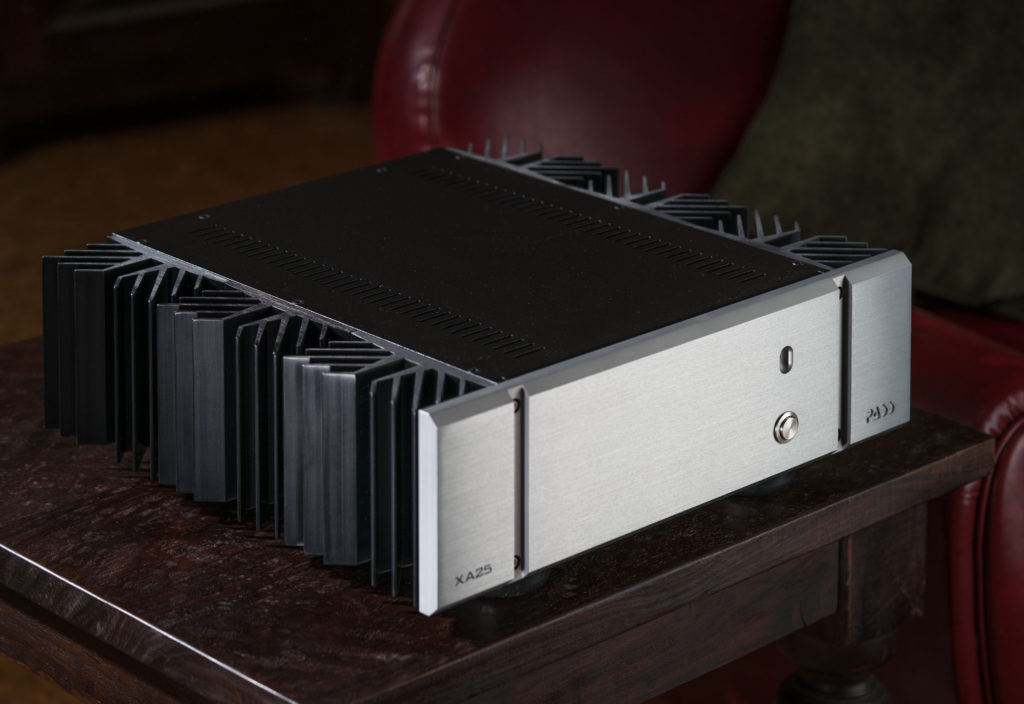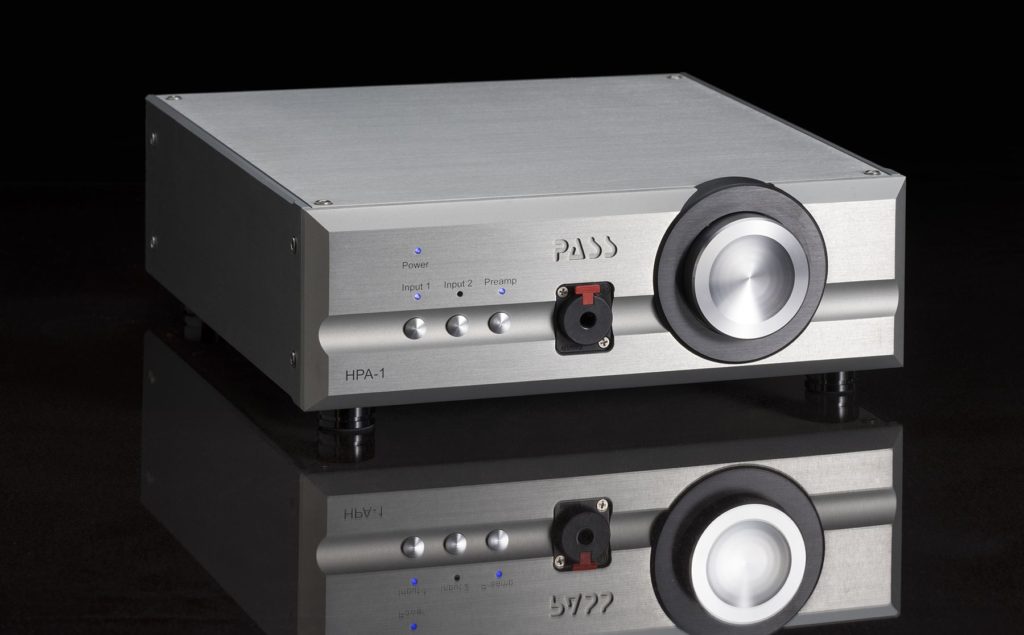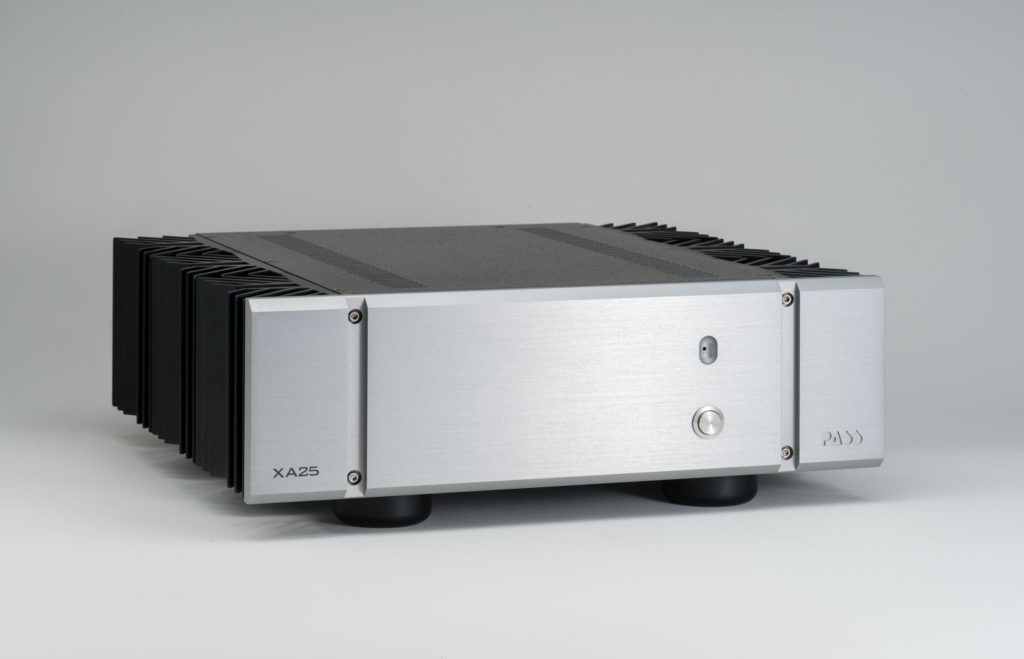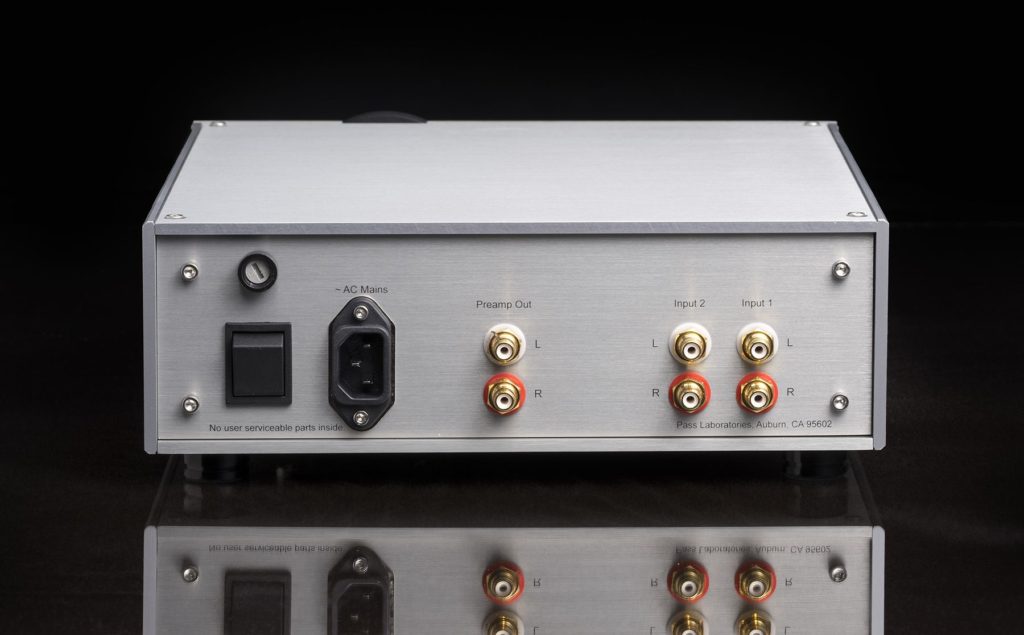
According to Pass Labs, the XA25 is not meant as an “entry-level” model but is a rather more affordable, smaller, and lighter Pass Labs Class A power amplifier, a pure Class A amplifier. According to Nelson Pass, “The new XA25 is intended to appeal to those wanting the performance without the frills in a chassis that will fit on a shelf and can be lifted without the assistance of ruffians.” This last statement about its size and weight excited me because for the last ten years my reference amp has been either the Wavac EC300B or the Pass Labs XA30.8. The Wavac weighs 65 pounds, but 85 percent of that weight is in the back and with two NOS Western Electric 300Bs in the front moving it was scary. The Pass Labs weighs 100 pounds. So, I have to admit that when I saw Pass has a new XA amp that weighs in at a mere 55 pounds and is only 17 inches deep, I thought that I had to give it a try.
Background
All of the other Pass Labs XA amplifiers are FET amplifiers with large banks of capacitors, excessive output stages, huge heat sinks and massive power supplies. They use the highest quality components in simple linear topologies, assembled and tested with care and subtlety. Yes, they measure well and are reliable, but Nelson would tell you about how they sound and not about how they measure.
The XA25 came about like so many things in audio; a designer discovers a new device and sets out to see if they can make something great from it. In this case, it was a new power FET technology that is large enough to replace banks of parallel transistors with a single pair of these industrial devices that each have a 700-watt /40-amp rating. They connect directly to the loudspeaker without ballast resistors for the lowest possible distortion and highest damping factor which makes it possible to have a greater Class A operation into low impedance and reactive loads. The XA25 is direct coupled and has no DC servos or frequency compensation.
Setting Up the XA25
When unpacking the XA25, I became aware of just how much smaller this amp is. At only 17 inches wide, 17.4 inches deep and nearly 60 pounds lighter, it is so much easier to negotiate when installing it in my system. It was much more difficult to remove my Pass Labs XA30.8 from my system than it was to install the XA25. Plugging it in and connecting the speaker cables was pretty much all there was to setting it up in my reference system which consists of a pair of Teresonic Ingenium XR speakers, an AMG V12 turntable with an AMG V12 Turbo tonearm and a DS Audio Master1 Optical Cartridge.
I used three different line stages for this review. The first one was my Emia Remote Autoformer, then the Pass Labs HPA-1 (I know it’s a headphone amp, but it’s a heck of a preamp also) and last I used the LTA MZ2-S as a preamp. With all three of these, the amp behaved well and sounded great. I started with the Emia because that’s what I use with the XA30.8 in my reference system, but I ended up with doing my final listening with the HPA-1. The two Pass Labs products had a very nice synergy.

Break-In and Warm-Up
The Pass Labs XA25 like the other Pass Labs’ amps takes a while to break-in. Now don’t get me wrong, the XA25 sounds great right out of the box, but it is slightly veiled. These veils will be lifted with time. Because of the current draw of the XA25, you will probably want to make use of that standby switch. The amp takes nearly an hour to come to life when coming out of standby, but if you turn it completely off with the switch on the back, then it’s a different story. Then it takes at least half a day of playing to come around.
A couple of other observations before I begin to talk about its sound. First as I’ve already said, I love its size and weight. Second, it doesn’t get nearly as hot the XA30.8 and not even close to as hot as any of the monoblocks. One last small but nice plus is that it doesn’t make the electric meter run as fast.
Listening
Because of the difference in its design, the XA25 is currently the only in-production amp in the “XA series” of amps from Pass Labs that’s not a Point 8 design. Still, the XA25 amp doesn’t sound like their .5 amps either; it sounds like itself. The XA25 is not quite as transparent as the 30.8, but it has a wonderful tube-like immediacy in the midrange. What I’m saying is the XA25 is transparent enough that it never reduced the musicality of my system. Its bass is not as controlled as the 30.8, but the bass is harmonically correct, full but not the least bit loose, it possesses the bass I hear from world-class tube amps but from a transistor amp.
As I listened to album after album, I could hear the textures, colors, tones, and harmonics of music in a way that was very moving. The system’s timbre realism with individual instruments and voices was as satisfying with the XA25 as it had been with any amp. All of this added up to enable my system to play music with a wonderful lifelike flow.
What the XA25 does even better than the XA30.8 is the way it involved me in a wonderful musical journey. I could hear the venue as the music is played in a hall, a club, an outdoor arena or a studio. Play one of the Mahler symphonies recorded at a live performance in Davies Hall (a hall Becky and I frequent often), and I could hear the same kind of spatial cues I’m use to when hearing a performance in the same space.
This kind of musical journey doesn’t come easily. I think part of what makes this possible is how quiet this amp is. This may explain why spatial cues are so easily experienced. The system allows me to feel the rhythm of performances. The music was very dynamic, robust, and most importantly it sounded alive. Voices were alive and musical.

With the XA25 in the system, music has an attention-grabbing effect that makes it hard not to just stop and listen. In fact, it’s one of those pieces of audio equipment that makes audio reviewers write trite things like, “It was hard to write while I was listening.” The XA25 plays music with a rich, incandescent, punchy and liquid sound. It also has an organic way with the sound that makes it more emotionally involving.
In my reviews of the XA30.8, I said, “Both the EC 300B, a SET tube amp, and the First Watt SIT, a single-ended class A transistor amp, build the sound from the midrange out. It’s like the midrange is the main attraction, and the bass and treble are there to finish out the sound. The Pass Labs XA30.8 builds the sound on a foundation of bass, mid-bass, and power.” Well, one of the ways that the XA25 is different from the XA30.8 is that it is more like the SET and SIT amps in that it builds the sound from the midrange out. The midrange is immediate, alive and can pull off that scary real thing with voices.
Like some great vintage amps and the 30.8, the XA25 plays music with big tone. The XA25 doesn’t sound “tubey.” It just has the big, full-colored tone and immediacy of a really good SET amp. The amp was exceptional at letting me hear the layering of the music. It also did a great job of letting me hear the space and air around performers.
The XA25 has good scale and a good soundstage, but it’s not quite in the league with the XA30.8. It is, however, every bit as good as the Wavac EC300B and First Watt SIT-1; so it’s no slouch when it comes to soundstaging. The soundstage is not always big, but the size depends on the recording and the venue. It’s the kind of soundstage that when combined with good imaging and detail lets you hear the recording with a realistic, holistic soundstage.

Are there any negatives with the XA25? Well, only by comparison to the XA30.8 that I think is the best amp I have ever heard that puts out more than one-watt. What I haven’t talked about is how this amp sounds when paired with the Pass Labs HPA-1 Headphone Amplifier used as a preamp. With the HPA-1 you are basically getting a Pass Labs preamp with a world-class headphone amp thrown in for $200 less than the XP-10. This combination seems made for each other, heck maybe they were. The sound was every bit as good with the Xp-10 as it was with my more expensive linestage. I was very impressed, and stay tuned for a review of the HPA-1 as a headphone amp soon.
Conclusion
Let me close with a little on my journey with Pass Labs amps; for years I considered their XA.5 series of amps were the best transistor amps in production. Still, they were just slightly more veiled and a little too polite for my midrange taste compared to my Wavac EC-300B. Then along came the Pass Labs XA30.8, which had none of these weaknesses in my reference system. I found the XA30.8 to be a total revelation. When the XA25 came out, I couldn’t wait to hear it. In years past, some of my all-time favorite amps had been 25-watt Class A amps. The XA25 did not disappoint. The biggest difference between the 30.8 and the 25 is in how they build their sound as I mentioned above. The 30.8 from the bass up and the 25 like a SET tube amp from the midrange out.
In the end, in it’s hard for me to say if I prefer the XA30.8 or the XA25. The XA25 is exactly what Nelson Pass said in the quote I share above, “The new XA25 is intended to appeal to those wanting the performance without the frills in a chassis that will fit on a shelf and can be lifted without the assistance of ruffians.” Not only that, it cost almost two grand less than the XA30.8. The XA25 is simply an amazing amp; match with the Pass Labs HPA-1, and you have an amp and preamp that work together so well. Both are highly recommended!
And, speaking of my journey with Pass Labs amps, Becky and I visited their factory in Auburn, CA just a few weeks ago, and saw their dedication to building quality amps and taking care of their customers first-hand. You can read more about our visit here.
XA25 Specifications
Price: $4,900
Output power: 2 x 25 Watts Class A @ 8 ohms, 2x 50 Watts Class A @ 4 ohms, 2x 100 Watts Class A/AB @ 2 ohms
Distortion: 0.1% @ 25 Watts, 8 ohms, 1 KHz, 0.1% @ 50 Watts, 4 ohms, 1 KHz
Freq. Response: DC to 3dB @ 200 KHz
Gain: 20 dB gain
Noise: Output 100 uV unweighted 20 to 20 KHz
Damping Factor: 200
Slew: 100 V/uS
Input Impedance: 47 Kohm
Peak Current: 10 Amp output (200 Watts into 2 ohms) Independent of loudspeaker load phase.
Protection: Shutdown at 10 amps output
Idle Power draw: 200 watts total
Dimensions: 17″ W x 17.4″ D x 6″ H
Weight: 46 pounds
HPA-1 Headphone Amplifier Specifications
Price: $3,500
Description: Solid-state headphone amplifier/line preamplifier
Analog inputs: 2 unbalanced (RCA).
Analog outputs: 1 pair unbalanced (RCA), 1 locking ¼” headphone jack. Maximum output power: 3500mW into 20 ohms, 200mW into 300 ohms.
Frequency range: 10Hz–100kHz.
Voltage gain: 8dB.
Input impedance: 50k ohms.
Output impedance: <2 ohms, headphones.
Dimensions: 11″ W by 4.5″ H by 12.9″ D. Weight: 14 lbs
Manufacturer: Pass Laboratories Inc
www.passlabs.com
![]()

Hello, my name is Terry London and I review for hometheaterreview.com. I’m the two channel “only Music” reviewer and do not review home theater gear!
I think you are an excellent writer and have great “ears” and taste, and know how to but together a system with great synergy. I use both tubes/SS gear in my reference system and own a pair of XA-60.8’s, SET-2, reviewed the Pass Labs HPA-1 (it’s great as a line-stage as you know) and two weeks ago submitted my review on the XA-25. I had not read your review on it until after writing mine and we came to the same conclusions-what a wonderful music maker, indeed! For my taste and system synergy it might be the best Nelson and his crew have come up with yet. I drive the XA-25 with the LTA Micro-ZOTL ( Last year the Micro-ZOTL was one of my products of the year award winners) into the Tekton Design reference Ulfberht speakers which are 99dB efficient. It’s hard for me to leave my listening spot because of the beauty of the music.
One question: The XA-25 that I have in-house only has an on/off push button on the front plate and no power switch on the back that you mention in your review. So, there is no standby option on mine and therefore I leave it on always. As you mentioned if you turn it completely off, it takes quite along time to come back to its full “song”. Did you get an early prototype? I believe the current production model only has the one power switch and no stand-by option.
Terry,
Thanks for reading The Audio Beatnik and for the kind words. In regard to the power switch, I did not have an early unit but writing the review a while after installing it, I committed the sin of assumption. I just looked at mine and you are correct. I will correct my review and by the way I can’t believe no one at Pass caught this either. Thanks again.
I had be very very interested in the XA-25. Then I learned you loved the Micro Zotl also. I find the Micro Zotl to be one of the worst sounding audio products I’ve ever heard in the past 3-4 years. Now I’m left concerned about the XA-25.
Without knowing your system, I can’t explain the difference we are hearing. The Micro ZOTL needs to drive speakers that have at least 100 dB efficiency. This probably accounts for the difference in what we hear.
Jack thanks for the review on the XA25. I have been torn between the 30.8 and the new XA25 and was waiting for some reviewers take on the newer Pass. I do like the size of the XA25 a lot better and from your review the Sonics are outstanding. Since we both have similar tastes in equipment it sounds like either amp will be a sonic winner in my system. Hey you were suppose make this a easier decision. Still torn but I know the XA25 sonically competes.
Bob, thanks for reading the review and I think like most amp/speaker questions it will depend most on which speakers you need the amp to drive.
Hey Audio Beatnnik1,
My review on the XA25 just went up today on hometheaterreview.com. I thought it might be interesting for you to see my take on this great amplifier and how we agree why it’s a music maker of the highest order. I found it hard now to go back to my XA-60.8’s, and they in their own right are wonderful amps, because the emotional response towards the music that the XA25 gives me is much stronger then in the mono-blocks.
PS: If you have not heard the Tekton Design Double Impacts or Ulfberhts you owe to yourself to hear them. I believe with your taste in sound you would find these speakers break through regarding their overall presentation of music.
Terry
Thanks for the detailed review on the XA-25, and the XA-30.8 previously.
Between the XA-25 and XA-30, which (if any) would you recommend for driving Audio Note AN-E speakers?
I’m currently using an Audio Note OTO and am looking for something with better bass while retaining the harmonic qualities of the Oto. The natural place to look would be Audio Note’s higher level amplifiers, but for practical reasons I don’t want an amplifier with big, hot tubes.
Thanks!
Hi Jack!
First off thank you for numerous excellent reviews over the years. It seems we have very similar tastes. Your review of the Emia led me to build a DIY Slagleformer passive preamp which easily bested my beloved tubed line stage which I promptly sold. Then during recent cable rolling adventures, I spotted your review of the HF UR and found a used set that was available for audition. Low and behold, I now have two pairs in my system.
Now, I’ve the itch to upgrade my amp. I’m currently using a 70W push pull KT90/6550 based amp to drive 90db, 4 ohm speakers with Accuton ceramic drivers. While I love the mid-range liquidity, and the reasonably good resolution, I am interested in perhaps a bit more transient snap, bass grip, and any improvement in micro dynamics or reduction in veil that might still be obtainable. I’m not currently disappointed with the microdynamics I have, but sometimes you don’t know what you’re missing until you hear it for the first time! Of course I’m a sucker for the mid-range liquidity and tone of my current tube amp, so don’t want to lose that either.
In light of this, Jack, which way do you think you might you lean – 30.8 vs 25? I’d also be curious where you felt the 25 exceeded the 30.8 if you wouldn’t mind sharing. Feel free to drop me an email if you’d prefer to discuss offline.
Much appreciated!
LJ
U,
Thanks for reading our site and I assume you know I can’t really answer the question I can’t answer this question with that little info. Also, I have never heard of your system, but I can tell you that I bet you would love either amp. Since you said you are looking for a bit more transient snap, bass grip, and any improvement in microdynamics or reduction , I would think you would be happiest with the 30.8.
jack
Hello,
By reading a number of reviews I’m confused more than ever by the choice between the 25 and the 30.8.
I listen to primarily to classical symphonic, opera and classic jazz.
My speakers have an efficiency rating of 89dbs.
Thoughts on what I might be happier with as I won’t be able to audition both?
Thanks very much.
P
Sorry, but that’s not enough info for me to make a recommendation. It would be helpful to know what speakers and source you are using.
Thanks,
jack
Thanks so much for responding.
Arc Ref 10.
Dali Epicon 8s
Ayon Digital
VPI Scout
Thank you.
With the Dali speakers, I would definatley go with the XA30.8.
Thank you. That was what my instinct was telling me.
HI,
Any recommendation for driving B&W 804 d3 with xa25 or xa30.8? My source is Roksan k3 and emotive xsp 1 gen 2 preamp. Thanks
Hi. Looking to see if you can help me too
I have Harbeth SHL5+ with a pass labs Pre XP-12
Do I go with xa25 or xa30.8 or xa60.8. Reading Terry’s review about not going back to 60.8 confused me further.
Thanks
I have the Dynaudio Special 40 speakers which are rated at 86db sensitivity and been trying to determine which Pass Labs amplifier would be the best fit. I’m using the Pass Labs HPA-1 as my preamp. I have a Chord Qutest DAC which is fed by my computer and CD transport. A Rega P3 connected through the Lounge Audio LCR MK III phono preamp. The size and heat output of the XA30.8 concerns me so I’m wondering if the XA25 will drive my speakers or not.
Hi Mike, I think the short answer is yes, it should be fine. But if you wanted to really find out you should get a hold of the impedance graph of the speaker and send that off to PassLabs to see what they think. I could not find the graph from Dynaudio’s website, maybe I missed it or you could email them.